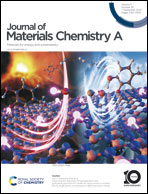Distinguishing photo-induced oxygen attack on alkyl chain versus conjugated backbone for alkylthienyl-benzodithiophene (BDTT)-based push–pull polymers†
Abstract
Synthetic design has enabled increasing power conversion efficiency advances in organic photovoltaics (OPV). One continuing knowledge gap is detailed understanding of single-material chemical (photo)stability. Many considerations are based on prior OPV-relevant donor homopolymer systems rather than the next-generation push–pull architectures. Generally, energetic offsets between the lowest occupied molecular orbital of the donor and molecular oxygen are assumed to dictate kinetics of photo-induced charge transfer to a super oxide radical. Herein we determine the ambient-induced photo-degradation pathways, presented as proposed site-specific arrow-pushing mechanisms, for five donor polymers all containing the same push unit – alkylthienyl-substituted-benzodithiophene (BDTT) – but with chemically distinct pull units. The donor-only polymer films were subject to controlled photobleaching in air as an accelerated degradation approach, coupled with simultaneous monitoring of absorptance. Sample subsets were periodically removed and analyzed with X-ray photoelectron spectroscopy, to evaluate near-surface chemical composition and oxygen additions to hetero reporter atoms on either the BDTT push unit or distinct pull unit (i.e., sulphur and nitrogen). This methodology allows us to distinguish between different mechanisms of bond cleavage and formation. Overall, we find that neither polymer redox properties nor individual push or pull unit stability are sufficient to predict photo-oxidative degradation of these polymers. Rather, there is a greater dependence on the susceptibility of unique structural groups within a polymeric system. Alkyl chain oxygen addition is generally the first attack site and direct sulfur oxidation on the conjugated backbone occurs after saturation of the alkyl chain initiation sites. This work provides a standard that could be used to evaluate relative photo-oxidative (in)stability for new OPV materials quickly – prior to time-consuming device optimization – and demonstrates an effective methodology for correlating optical degradation with chemical structure alterations via spectroscopic signatures to guide synthetic design.

- This article is part of the themed collection: #MyFirstJMCA


 Please wait while we load your content...
Please wait while we load your content...